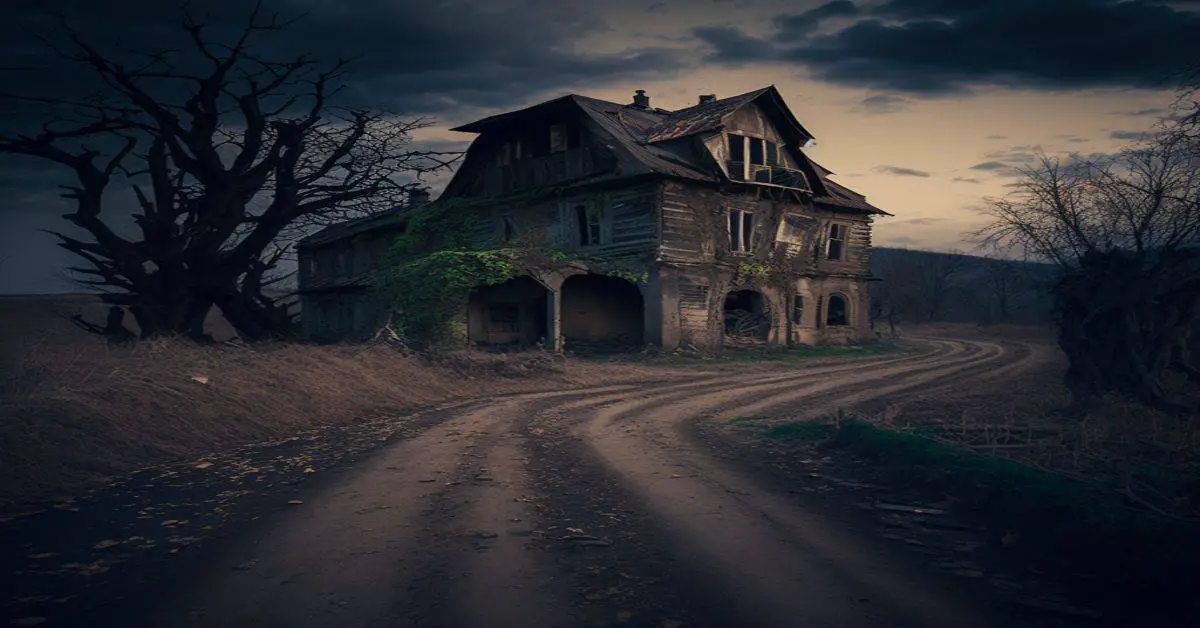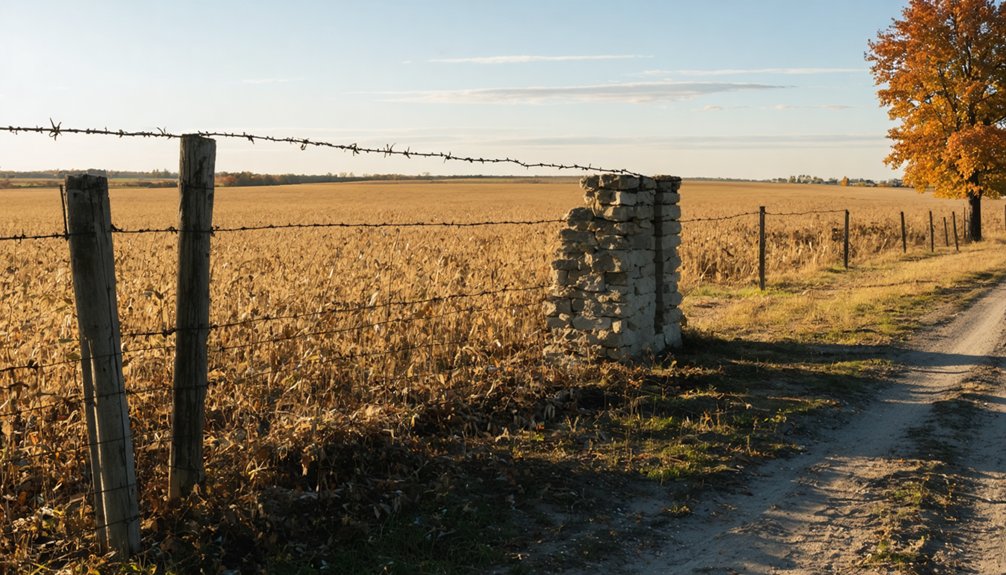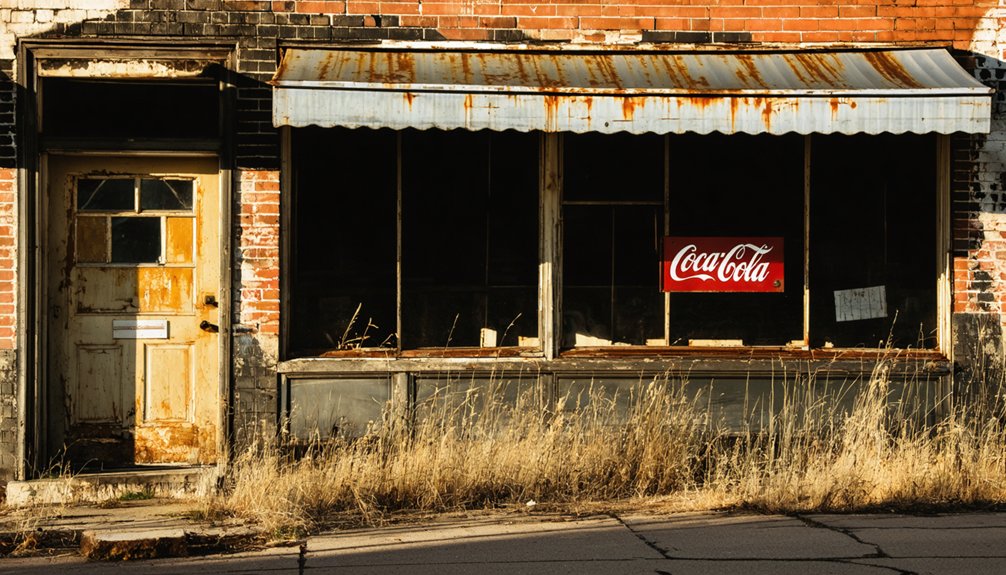You’ll find McVey’s remains along the former Illinois Central Railroad line in central Illinois, where a once-bustling rail town thrived between Springfield and Champaign-Urbana. The town flourished in the early 1900s with the addition of the Illinois Traction System, supporting local merchants, a foundry, and essential businesses like Primas Bakery. Today, only scattered foundations and an earthen railroad berm mark this ghost town‘s location, though its rich railroad heritage holds many untold stories.
Key Takeaways
- McVey was a thriving Illinois railroad town established in the 1850s along the Illinois Central Railroad between Springfield, Carlinville, and Champaign-Urbana.
- The town’s decline began after World War II due to increased automobile usage and changing transportation patterns that bypassed smaller communities.
- A devastating flood in 1937 destroyed 400 homes and economic structures, contributing significantly to the town’s eventual abandonment.
- Only scattered building foundations, cellar depressions, and the raised earthen berm of the original railroad grade remain visible today.
- Local historical societies preserve McVey’s memory through oral histories, railroad documents, maps, and land records of the former community.
The Rise of McVey Along the Railroad
As the Illinois Central Railroad expanded its reach through central Illinois in the 1850s, McVey emerged as one of many strategic settlements along the growing rail network. You’d find McVey positioned advantageously between major regional hubs like Springfield, Carlinville, and Champaign-Urbana, benefiting from both passenger and freight services that fueled local economic growth.
The railroad expansion transformed McVey’s landscape, as the Illinois Central’s ambitious 702-mile track construction brought new opportunities for commerce and settlement. The area’s development aligned with William B. McKinley’s vision of connecting major cities across Illinois. Like early Tazewell County rail efforts, the community celebrated when the first spike was driven to mark construction progress.
You could witness the economic impact firsthand through the development of essential infrastructure near the tracks, including depots and town facilities. The later addition of the Illinois Traction System in the early 1900s further enhanced McVey’s transportation connections, offering both electric passenger service and freight options to residents and businesses.
Life in Early 20th Century McVey
If you’d visited McVey in the early 1900s, you’d have seen railroad workers starting their days before dawn, heading to the railyard for their shifts maintaining tracks and operating trains.
The town’s Main Street bustled with activity as general stores, a post office, and other small businesses served both railway employees and local farming families throughout the day.
Local merchants often extended their operating hours to accommodate the railroad workers’ irregular schedules, creating a symbiotic relationship between the town’s commerce and its railway operations.
The local foundry provided steady employment, with workers like Larry D McVey putting in 25 years at Caterpillar.
Many of the railroad workers were descendants of the earliest McVey settlers who had come to America in the late 1700s.
Railroad Workers’ Daily Routine
While McVey’s railroad workers endured grueling schedules in the early 20th century, their daily routines formed the backbone of the town’s industrial life.
You’d find them starting their shifts before dawn, tackling dangerous tasks like laying rails, grading terrain, and maintaining bridges in all weather conditions. Railroad safety was a constant concern, with accidents and derailments posing real threats to these hardworking crews. Workers typically earned between 75 cents to $1.50 per day. Illinois saw its coal production peak during this era, keeping rail crews especially busy transporting the valuable mineral.
As an immigrant worker, you’d likely live in crowded housing near the rail yard, sharing the immigrant struggles of your fellow laborers.
You’d join mutual aid societies for support while working specialized roles – perhaps as an engineer, fireman, or brakeman. Your day would involve coordinating with expanding rail networks, checking track integrity, and servicing engines, all while adapting to the evolving needs of McVey’s growing railroad operations.
Business on Main Street
Along McVey’s bustling Main Street in the early 1900s, you’d find a vibrant mix of essential businesses serving the railroad town’s growing population.
The business evolution started with a general store that stocked everything from work boots to flour, while the local bakery filled the morning air with the aroma of fresh bread. One popular establishment, Primas Bakery, served residents from 1890 before later housing the town’s post office. You’d see the hardware store supplying tools to railroad workers and farmers alike, and the tailor shop busy with alterations. The town’s commission form government, established in 1912, helped regulate and organize these commercial activities.
These establishments weren’t just places of commerce – they embodied community resilience. Local entrepreneurs adapted their services to meet changing needs, sponsored town events, and created jobs for residents.
Their buildings, with their distinctive architectural features and hand-painted signs, became social hubs where you’d catch up on local news while picking up your mail at the post office.
Railroad’s Influence on Town Development
During the early 20th century, the Illinois Traction System revolutionized town development across Central Illinois through its extensive electric rail network.
You’ll find that railroad expansion transformed communities like McVey, as the ITS grew to over 550 miles of track connecting St. Louis to Springfield and beyond.
The transportation evolution brought by ITS shaped town development in three key ways:
- Rail lines determined town layouts and influenced where new settlements would emerge.
- Track placement led to strategic land subdivision for homes and agricultural use.
- Shared roadways between trolleys and automobiles created unique infrastructure within town centers.
These developments weren’t just about moving people – they represented freedom of movement and economic opportunity for small towns, connecting them to larger urban centers through regular passenger and freight service. By 1945, the system was carrying 8.6 million passengers annually, demonstrating its vital role in connecting communities.
Economic Activities and Commerce
Because agriculture drove the local economy, McVey’s early commerce centered on grain, beef, and pork trading.
You’d find settlers engaging in agricultural trade through informal, trust-based transactions, often using labor, barter, and promissory notes instead of cash. Local general stores and blacksmith shops served as essential commercial hubs where you could acquire important goods and services for farming operations.
While McVey lacked municipal buildings, its railroad connection provided significant market access for nearby residents. The Illinois Corn Growers Association maintained a prominent presence in the region, complete with grain-weighing facilities for local farmers.
Despite its small size and minimal infrastructure, McVey’s railroad link served as a vital economic lifeline for area farmers.
Land speculation played a significant role in the area’s development, with settlers buying and selling improved claims to profit from increasing land values.
The surrounding towns offered additional services like banks, ice cream parlors, and funeral homes, creating a modest but diverse commercial network that supported the agricultural community.
The Gradual Decline of a Rail Town
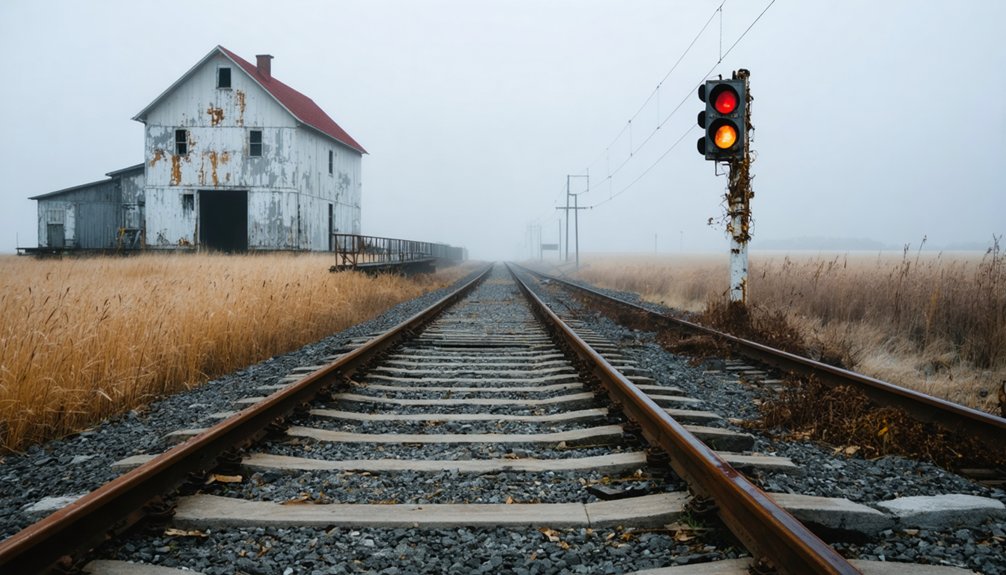
While McVey once thrived as a bustling rail stop, the town’s decline mirrored the fate of many small railroad communities after World War II. The transportation evolution away from rail service dealt significant blows to McVey’s significance, as larger railroad companies shifted their focus to main lines and abandoned smaller branch connections.
You’ll find these key factors shaped McVey’s downturn:
- Growing automobile ownership and improved highways reduced dependence on passenger rail service.
- Changes in freight patterns led major railroads to bypass smaller communities.
- Multiple railroad ownership changes resulted in decreased investment and eventual service cutbacks.
The town’s isolation intensified as urbanization drew people away, while technological advances in rail operations eliminated the need for frequent stops that had once made McVey an essential waypoint during the railroad expansion era.
Architectural Legacy and Lost Structures
The architectural remnants of McVey tell a bittersweet story of a once-thriving railroad town‘s physical decline.
You’ll find traces of architectural influences in the surviving foundations, where wood-framed homes and industrial buildings once stood. Before the devastating 1937 flood, you’d have seen 400 modest homes, a bustling boat yard, lime kiln, and grain elevators that reflected the community’s economic significance.
The town’s community resilience showed in their adaptive responses – they built levees and elevated structures to combat frequent flooding.
You can still spot concrete grain elevators that replaced wooden ones after fires, and remnants of rail-related architecture that once served the Wabash Line.
Today, these scattered ruins and archaeological sites are all that’s left of McVey’s once-proud architectural heritage.
Notable Residents and Community Life

Railroad workers in McVey would gather at the local store after their shifts to share news and stories from their day’s work on the tracks.
You’d often find these workers swapping tales of rail accidents, schedule changes, and freight shipments while picking up essential supplies for their families.
The store became such an important social hub that even residents who didn’t work on the railroad would stop by to catch up on the latest community happenings and exchange information about local events.
Railroad Workers’ Daily Lives
Life for thousands of immigrant railroad workers in McVey centered around harsh living conditions and communal survival.
These laborers, mainly from Ireland, Germany, and Britain, faced brutal challenges while building Illinois’ expanding rail network. You’ll find immigrant struggles woven through their daily routines, from sharing cramped boxcar housing to maintaining cultural labor traditions in their new homeland.
Key aspects of railroad workers’ lives included:
- Living spaces measuring just 300 square feet, often shared by up to 10 people with makeshift curtains for privacy.
- Dangerous working conditions with frequent accidents, minimal pay, and long hours maintaining tracks and equipment.
- Strong community bonds formed through shared cultural practices, multigenerational living, and religious traditions that helped families survive the harsh conditions.
Local Store Gathering Place
At McVey’s heart stood a modest general store that served as the town’s vibrant social nucleus, where residents gathered daily to exchange news, share stories, and purchase essential supplies.
You’d find regular patrons stopping by not just for goods, but for meaningful local interactions that strengthened community bonds. The store’s owner, while unnamed in records, was among McVey’s most influential residents, often extending credit to neighbors during tough times.
Community gatherings frequently took place at the store, which doubled as an informal meeting hall where families connected across generations.
When postal service was available, you’d collect your mail here too. The store’s eventual closure marked a turning point in McVey’s decline, though its memory lives on as a symbol of the town’s once-thriving spirit.
McVey’s Place in Illinois Railroad History
While many Illinois towns emerged alongside the expanding railroad networks of the mid-1800s, McVey’s development closely aligned with the broader pattern of rail-driven settlement in Macoupin County.
Like neighboring Nilwood, McVey’s growth followed the familiar path of railroad expansion and settlement patterns that shaped Illinois communities.
The railroad’s influence on McVey manifested in three key ways:
- Rail access enabled essential connections to Chicago markets and regional trade networks
- The local depot served as a hub for mail, communications, and commerce
- Railroad employees, including telegraph operators like Bertha McVey, became integral community members
You’ll find McVey’s story mirrors countless other Illinois railroad towns where tracks laid the foundation for growth, connecting these small communities to the wider economic opportunities of the era.
Archaeological Findings and Remnants
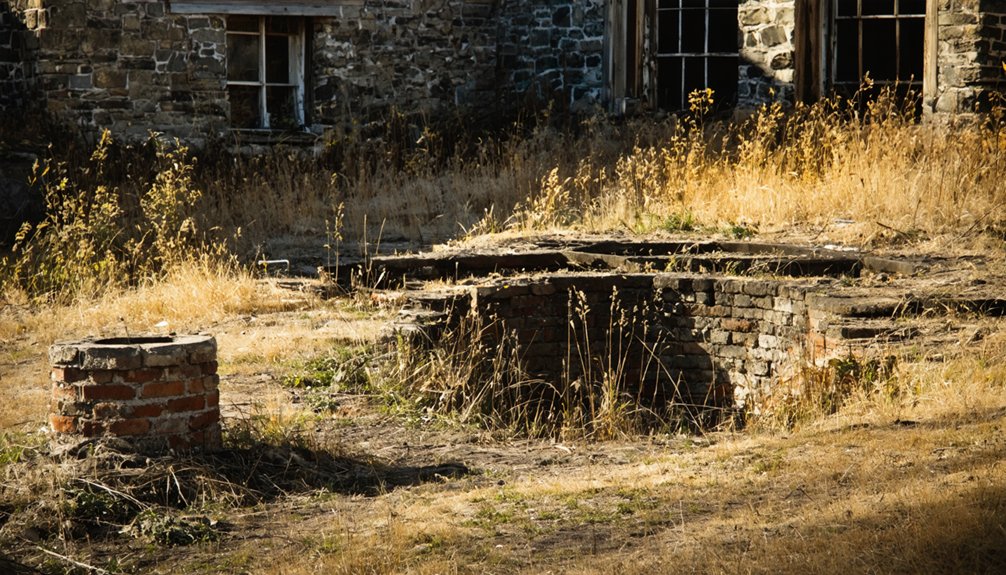
You’ll find scattered building foundations and cellar depressions throughout McVey’s former townsite, marking where homes and businesses once stood along the railroad corridor.
The raised earthen berm of the original railroad grade remains visible, though the tracks and ties were removed decades ago.
Local residents have recovered period artifacts like glass bottles, ceramic fragments, and metal tools from the site, though no formal archaeological survey has documented these finds.
Foundation and Building Traces
Archaeological investigations of McVey’s remains have revealed a modest collection of structural evidence across the former settlement in Douglas County, Illinois.
Through careful building archaeology studies, you’ll find visible foundation remnants that tell the story of this vanished community.
Key structural features you can observe include:
- Partial stone and brick foundations, along with weathered wooden posts that align with historic property boundaries
- Cellar depressions and holes in pastures and wooded areas, marking where homes once stood
- Former roadbeds, now overgrown but still traceable, connecting the various foundation sites
Metal detector surveys have uncovered building hardware like nails and hinges near these sites, while local oral histories suggest locations of important community structures, including a general store, post office, and church.
Railroad Track Remnants
Beyond the building foundations, McVey’s most prominent physical remnants come from its railroad heritage.
As you explore the site, you’ll find railroad archaeology in the form of raised earthen beds that once supported the tracks, along with scattered metal spikes and tie plates that have weathered decades of exposure.
The track preservation is minimal, as most rails were salvaged for scrap, but you can still trace the railroad’s path through linear vegetation patterns and subtle grade changes in the terrain.
Look for surviving concrete ties partially buried in the soil and distinctive cuts through the landscape where the rail company altered the ground for ideal track placement.
These silent markers tell the story of McVey’s essential connection to Illinois’ rail network.
Local Artifact Recovery
Despite extensive searches of historical records and local archives, no formal archaeological excavations or systematic artifact recovery efforts have been documented for McVey’s ghost town site.
While local legends and ghost stories have sparked interest in potential artifacts, McVey stands in stark contrast to Illinois’ rich archaeological heritage, particularly when compared to sites like Cahokia.
If you’re interested in exploring the area’s historical remnants, consider these key points:
- No verified artifacts have been recovered from McVey’s town limits.
- Unlike nearby archaeological sites, McVey lacks any documented burial grounds or significant structural remains.
- The absence of formal archaeological studies leaves the site’s material history largely unexplored, making it an untapped resource for future research.
Preserving McVey’s Historical Memory
While McVey’s physical structures have largely vanished from the Illinois landscape, preserving its historical memory remains crucial for understanding the region’s development.
You’ll find that without remaining buildings or visible infrastructure, the task of preservation faces significant archival challenges. Limited documentation and minimal community advocacy make it difficult to piece together McVey’s story.
You can help preserve McVey’s legacy through local historical societies and digital archives. By collecting oral histories from nearby residents and examining railroad documents, maps, and land records, you’ll contribute to reconstructing the town’s narrative.
Consider supporting initiatives to install informational markers or create online resources that guarantee McVey’s place in Illinois history isn’t forgotten, despite the physical traces that time and nature have erased.
Frequently Asked Questions
What Native American Tribes Originally Inhabited the Mcvey Area?
You’ll find the Illinois Confederation’s tribes, including the Cahokia, Kaskaskia, Michigamea, Peoria, and Tamaroa, were the native tribes whose cultural impact originally shaped this area before European settlement.
Were There Any Documented Paranormal Activities in Abandoned Mcvey Buildings?
You won’t find any confirmed paranormal sightings or ghostly encounters in McVey’s abandoned buildings, as there’s no documented evidence of supernatural activity in the official records or local investigations.
What Happened to the Cemetery and Burial Records of Mcvey?
Like a corrupted hard drive, you’ll find McVey’s cemetery records have vanished. Most burial sites became overgrown, though the Caylor family tomb remains preserved. Local preservation efforts couldn’t prevent the loss of documentation.
Did Any Famous Outlaws or Gangsters Ever Pass Through Mcvey?
You won’t find evidence of famous outlaws or gangster encounters in this location. Historical records don’t show any documented criminal activity or notable figures passing through this small railroad stop.
What Was the Highest Recorded Population of Mcvey?
You won’t find exact population records for McVey’s historic significance, as demographic trends weren’t well documented. Based on similar rural settlements in Macoupin County, it likely never exceeded 200 residents.
References
- https://www.youtube.com/watch?v=93k0qtvzkn4&vl=en-US
- https://www.heraldtimesonline.com/story/lifestyle/home-garden/2021/01/15/some-illinois-ghost-towns/43846097/
- http://cantontornado36.blogspot.com/2017/04/ghost-towns-of-fulton-county-illinois.html
- https://www.youtube.com/watch?v=gM3ZIgtFzBk
- https://freepages.rootsweb.com/~gtusa/history/usa/il.htm
- https://drloihjournal.blogspot.com/p/lost-towns-of-illinois-series.html
- https://en.wikipedia.org/wiki/List_of_ghost_towns_in_Illinois
- https://www.ghosttowns.com/states/il/mcvey.html
- http://genealogytrails.com/ill/jefferson/ghostowns.html
- https://eblackcu.net/portal/archive/files/railroads006_9f2ec754be.pdf

